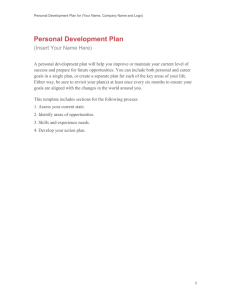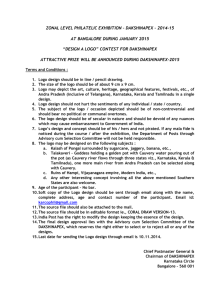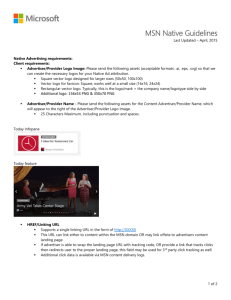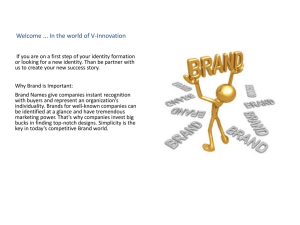Tense and Voice
advertisement
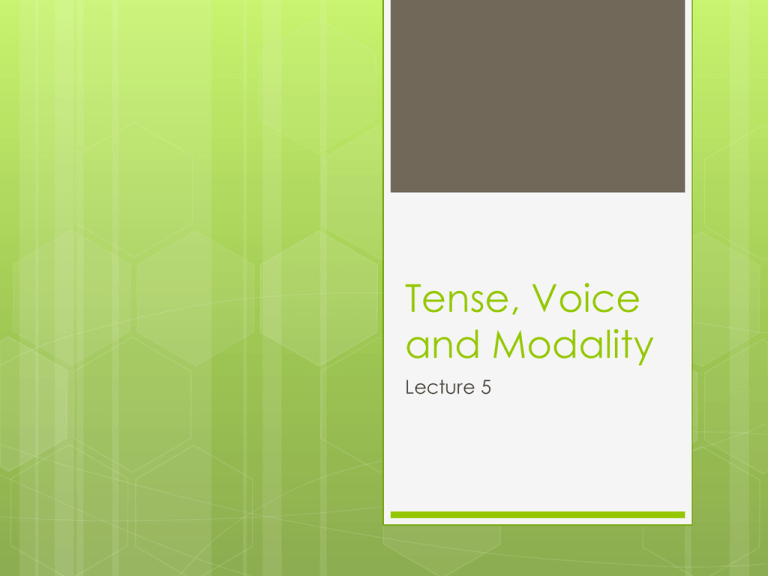
Tense, Voice and Modality Lecture 5 Tense 英语动词在表示时态时有两种形式的标记:过 去时和现在时,也有一些动词没有时态标记。 (1) 祈使句和非限定小句。 Pass me his drink please. Just dump it at the door there. Do ring Cathy if you feel like it. To cook for you is easy. 限定性小句可以有情态或时态标记,但无法两 者兼而有之。情态动词具有时态标记。 In 1971, he thought he could help his brother in his illness by writing about their childhood. I know I would put on weight. 现在时态: 第三人称单数 +(e)s 过去时态:规则动词+-ed ;不规则动词形式 多样 一般现在时 (1)现在的动作或状态;(2)现在的习惯性 行为 I think you might be wrong. Economists fear interest rate rise. She’s vegetarian but she eats chicken. (3)正在进行的动作 Here comes your mother. 一般现在时可表示过去的事件,常用于会话 And the guy driving the truck says, no we can’t; we’ve got an important meeting. 一般现在时可表示将来时间,出现在带表示将 来时间状语的句子,也出现在指将来时间的条 件小句或时间状语小句。 It’s open day on Wednesday. If I refuse to do what she says this time, who knows where my defiance will end? 一般过去时:过去发生的事 也可表示现在发生的事,但带有情感或态度 Did you want a cup of tea? Hi, Peggy this is Ellen at Sports Spectrum, um, I wanted to let you know we got your swimsuit in. Future time 英语没有表示将来时间的形式特征,将来时间 通常由动词短语中的情态或半情态动词来表示, 如will, shall, be going to. Even more precise coordination will be necessary. We shall give an account of the situation in Chapter Three. And he’s going to see it. 表示心理、情感、态度和逻辑状态的动词常用 一般现在时。表示心理、情感和态度的动词有 bet, care, doubt, fancy, know, mean, mind, reckon, suppose, thank, want等 表示逻辑状态的动词有differ, imply, tend, matter等 I don’t suppose that matters really. Customs differ, but the meaning is the same. 体(aspect) 体涉及动词所描述的事件或状态是否完成。 完成体表示事件或状态在某个时候已经完成。 进行体表示事件或状态在某个时候仍在进行之 中。 完成体和进行体可以与现在时态或过去时态连 用。 Voice 学术语篇中被动语态占 所有限定性动词的25%。 会话中被动语态占所有限定性动词的2%。 The tree fell down. The shop opens at 8 o’clock. The glass broke. The pen writes well. Phrasal verbs I used to make up stories for him. She held up her wrist; on it he made out a small dark bruise. I find myself obliged to make up ground. I can’t make out his handwriting. V + 副词: get along, get off, come about, take off V + 介词:ask for, deal with V + N + 介词: accuse … of, say farewell to, remind … of 这些短语动词可以由相同意义的及物动词所代 替。 Look like = resemble Think about = consider Ask for = request Deal with = handle Stand for = tolerate V + adverb + preposition: look forward to (=anticipate), put up with (=tolerate), get out of (=avoid), come up with, V+ prepositional phrase: bear in mind, take into account, take into consideration V + V: You have to make do, don’t you 情态 Palmer(2003)认为英语主要有四种情态: 认识情态(epistemic)、道义情态 (deontic)、动力情态(dynamic)和实据 情态(evidential)。 认识情态涉及的是可能性(possibility)和必要 性(necessity) 。 Company Logo 道义情态涉及的是说话人或他人的行动(例如: you may go now); 动力情态能力来自主语本身的身体和心理能力 (例如:They can run very fast)。 言据情态指说话人提供信息来源的实据。言据 情态主要有两类:报告(例如:He is said to be enormously rich)和感知(例如:I smelt that I was no longer welcome)。 Company Logo 情态 在Halliday(1994)看来,在命题中情态涉及 概率程度和经常程度。 在命令中,情态涉及职责的程度。在提供中, 情态涉及倾向性。 情态可由情态动词和情态附加语(modal adjunct)来体现; Company Logo 例如: That’s probably John. [情态化;概率程度; 情态附加语] He usually sits there all day. [情态化;经常 程度;情态附加语] You must really go there and see for yourself. [意态;职责;情态动词] We are willing to fight for it, if necessary. [意态;倾向性;谓语的延伸式] Company Logo 情态动词 情态动词是情态的一种重要的体现手段。在Palmer的模 式里,情态动词可表示认知、道义、动力和实据情态意 义。 不同情态动词能表达不同的情态意义 may表示可能的判断,表示说话人对命题的自信程度较 弱; will表示根据已知事实做出合理的判断, must表示根据已知事实进行的唯一可能的判断。 Have to和can表示说话人的责任或许可程度较弱, must和may表示说话人的责任和许可程度较高。 Company Logo Biber et al(1999)将英语情态动词分为三类:核心情 态动词、边缘情态动词和半情态动词。 核心情态动词 can, could, may, might, must, shall, should, will, would 边缘情态动词 dare (to), need (to), ought to, used to 半情态动词 have to, (had) better, (have) got to, be supposed to, be going to Company Logo Biber et al还根据这些情态动词的主要意义把他们分为 三大类: 情态意义 例 子 许可/可能性/能力 can, could, may, might 责任/必要性 must, should, (had) better, have (got) to, need to, ought to, be supposed to 意愿/预测 will, would, shall, be going to 在系统功能语言学里,情态动词具有高、中、 低三个值。Halliday按照高、中、低三个值将 情态动词分类如下: Company Logo 值 情态动词 高 must, ought to, need, has to, is to 中 will, would, shall, should 低 may, might, can, could 在对英语法律语篇和学术语篇的语料库分析中 我们发现: 情态动词may和shall构成了法律语篇的突出特 征; 情态动词will在学术语篇出现频率最高,can, would和may也占有一定的比例。 Company Logo The agreement shall include a detailed schedule of itemized charges for interconnection and each service or network element included in the agreement. Company Logo A person shall not, at any time during the protection period of a performance, make a direct recording of the performance without the authority of the performer. Company Logo The officer may enter the premises for the purpose of silencing the alarm. The officer may not enter premises by force under this section. The same mechanism which will produce the finest results when made to serve the underlying principles of scientific management, will lead to failure and disaster if accompanied by the wrong spirit in those who are using it. Company Logo



